Population Biology of the Non-Indigenous Rayed Pearl Oyster (Pinctada radiata) in the South Evoikos Gulf, Greece
Abstract
:1. Introduction
2. Materials and Methods
2.1. Study Area and Sampling Methodology
2.2. Statistical Analysis
2.3. Age and Growth
2.4. Mortality and Exploitation Rate
2.5. Relative Y/R and B/R Analysis: Knife-Edge Selection
3. Results
3.1. Population Structure
3.2. Sex Ratio
3.3. Allometric Relationships
3.4. Age Composition
3.5. Growth, Mortality, and Exploitation Rate
3.6. Probability of Capture—Lopt
3.7. Relative Y/R and B/R Analysis: Knife-Edge Selection
4. Discussion
5. Conclusions
Supplementary Materials
Author Contributions
Funding
Institutional Review Board Statement
Data Availability Statement
Conflicts of Interest
References
- Coll, M.; Piroddi, C.; Steenbeek, J.; Kaschner, K.; Ben Rais Lasram, F.; Aguzzi, J.; Ballesteros, E.; Bianchi, C.N.; Corbera, J.; Dailianis, T. The Biodiversity of the Mediterranean Sea: Estimates, Patterns, and Threats. PLoS ONE 2010, 5, e11842. [Google Scholar] [CrossRef]
- Sabelli, B.; Taviani, M. The Making of the Mediterranean Molluscan Biodiversity. In The Mediterranean Sea; Goffredo, S., Dubinsky, Z., Eds.; Springer: Dordrecht, The Netherlands, 2014; pp. 285–306. [Google Scholar] [CrossRef]
- Wada, K.T.; Tëmkin, I. Taxonomy and phylogeny. In The Pearl Oyster; Southgate, P.C., Lucas, J.S., Eds.; Elsevier: Amsterdam, The Netherlands, 2008; pp. 37–75. [Google Scholar]
- Gervis, M.H.; Sims, N.A. The Biology and Culture of Pearl Oysters (Bivalvia Pteriidae); WorldFish: Penang, Malaysia, 1992; Volume 21, ISBN 9718709274. [Google Scholar]
- Cunha, R.L.; Blanc, F.; Bonhomme, F.; Arnaud-Haond, S. Evolutionary Patterns in Pearl Oysters of the Genus Pinctada (Bivalvia: Pteriidae). Mar. Biotechnol. 2011, 13, 181–192. [Google Scholar] [CrossRef] [PubMed]
- Tëmkin, I. Molecular Phylogeny of Pearl Oysters and Their Relatives (Mollusca, Bivalvia, Pterioidea). BMC Evol. Biol. 2010, 10, 342. [Google Scholar] [CrossRef] [PubMed]
- WoRMS—World Register of Marine Species—Pinctada Radiata (Leach, 1814). Available online: https://www.marinespecies.org/aphia.php?p=taxdetails&id=140890 (accessed on 1 July 2024).
- Gofas, S.; Le Renard, J.; Bouchet, P. European Register of Marine Species: A Check-List of the Marine Species in Europe and a Bibliography of Guides to Their Identification. In Patrimoines Naturels; Costello, M.J., Ed.; Muséum National D’histoire Naturelle: Paris, France, 2001; pp. 180–213. [Google Scholar]
- Barbieri, M.; Deidun, A.; Maltagliati, F.; Castelli, A. A Contribution to the Phylogeography of Pinctada Imbricata Radiata (Leach, 1814) (Bivalvia: Pteriidae) from the Eastern Mediterranean Sea by Means of the Mitochondrial COI Marker. Ital. J. Zool. 2016, 83, 113–120. [Google Scholar] [CrossRef]
- Di Monterosato, T.A. Enumerazione e Sinonimia Delle Conchiglie Mediterranee. G. Sci. Nat. Econ. Palermo 1878, 61–115. [Google Scholar]
- Serbetis, C.D. L’acclimatation de La Meleagrina (Pinctada) Margaritifera (Lam.) En Grèce. Rapp. Procès-Verbaux Réunions Comm. Int. Pour L’exploration Sci. Mer Méditerranée 1963, 17, 271–272. [Google Scholar]
- Tlig-Zouari, S.; Rabaoui, L.; Irathni, I.; Diawara, M.; Ben Hassine, O.K. Comparative Morphometric Study of the Invasive Pearl Oyster Pinctada Radiata along the Tunisian Coastline. Biologia 2010, 65, 294–300. [Google Scholar] [CrossRef]
- Zenetos, A.; Akel, E.H.K.H.; Apostolidis, C.; Bilecenoglu, M.; Bitar, G.; Buchet, V.; Chalari, N.; Corsini-Foka, M.; Crocetta, F.; Dogrammatzi, A. New Mediterranean Biodiversity Records (April 2015). Mediterr. Mar. Sci. 2015, 16, 266–284. [Google Scholar] [CrossRef]
- Deidun, A.; Gianni, F.; Cilia, D.P.; Lodola, A.; Savini, D. Morphometric Analyses of a Pinctada Radiata (Leach, 1814) (Bivalvia: Pteriidae) Population in the Maltese Islands. J. Black Sea/Mediterr. Environ. 2014, 20, 1–12. [Google Scholar]
- Antit, M.; Gofas, S.; Salas, C.; Azzouna, A. One Hundred Years after Pinctada: An Update on Alien Mollusca in Tunisia. Mediterr. Mar. Sci. 2011, 12, 53. [Google Scholar] [CrossRef]
- Lodola, A.; Nicolini, L.; Savini, D.; Deidun, A.; Occhipinti-Ambrogi, A. Range Expansion and Biometric Features of Pinctada Imbricata Radiata (Bivalvia: Pteriidae) around Linosa Island, Central Mediterranean Sea (Italy). Ital. J. Zool. 2013, 80, 303–312. [Google Scholar] [CrossRef]
- Derbali, A.; Jarboui, O.; Ghorbel, M.; Dhieb, K. Reproductive Biology of the Pearl Oyster, Pinctada Radiata (Mollusca: Pteriidae), in Northern Kerkennah Island (Gulf of Gabes). Cah. Biol. Mar. 2009, 50, 215–222. [Google Scholar]
- Gerovasileiou, V.; Akel, E.S.H.K.; Akyol, O.; Alongi, G.; Azevedo, F.; Babali, N.; Bakiu, R.; Bariche, M.; Bennoui, A.; Castriota, L. New Mediterranean Biodiversity Records (July 2017). Mediterr. Mar. Sci. 2017, 18, 355–384. [Google Scholar] [CrossRef]
- Stasolla, G.; Riolo, F.; Macali, A.; Pierri, C.; Crocetta, F. Further Spreading in the Italian Seas of Already Established Non-Indigenous Mollusc Species. Mar. Biodivers. Rec. 2014, 7, e120. [Google Scholar] [CrossRef]
- Theodorou, J.A. On the Occurrence of Rayed Pearl Oyster Pinctada Imbricata Radiata (Leach, 1814) in Western Greece (Ionian Sea) and Its Biofouling Potential. Biharean Biol. 2019, 13, 4–7. [Google Scholar]
- Zenetos, A.; Gofas, S.; Verlaque, M.; Çinar, M.E.; García Raso, J.G.; Bianchi, C.N.; Morri, C.; Azzurro, E.; Bilecenoglu, M.; Froglia, C.; et al. Alien Species in the Mediterranean Sea by 2010. A Contribution to the Application of European Union’s Marine Strategy Framework Directive (MSFD). Part I. Spatial Distribution. Mediterr. Mar. Sci. 2010, 11, 381–493. [Google Scholar] [CrossRef]
- Streftaris, N.; Zenetos, A. Alien Marine Species in the Mediterranean—The 100 ‘Worst Invasives’ and Their Impact. Mediterr. Mar. Sci. 2006, 7, 87–118. [Google Scholar] [CrossRef]
- Kalopissis, J. Individus Perliers de Pinctada Radiata Dans Les Eaux Du Golfe Saronique. Thalass. Salentina 1981, 11, 105–108. [Google Scholar]
- Katsanevakis, S.; Lefkaditou, E.; Galinou-Mitsoudi, S.; Koutsoubas, D.; Zenetos, A. Molluscan Species of Minor Commercial Interest in Hellenic Seas: Distribution, Exploitation and Conservation Status. Mediterr. Mar. Sci. 2008, 9, 77. [Google Scholar] [CrossRef]
- Theodorou, J.A.; Viaene, J.; Sorgeloos, P.; Tzovenis, I. Production and Marketing Trends of the Cultured Mediterranean Mussel Mytilus Galloprovincialis Lamarck 1819, in Greece. J. Shellfish. Res. 2011, 30, 859–874. [Google Scholar] [CrossRef]
- Vassilopoulou, V.; Papaconstantinou, C. Marine Protected Areas as Reference Points for Precautionary Fisheries: A Case Study of Trawl Reserves in Greek Waters. In CIESM Workshop Series, Kerkenna Islands, Tunisia; CIESM: Villa Girasole, Monaco, 1999; Volume 17, pp. 1–96. [Google Scholar]
- Tsirogiannis, E.; Angelidis, P.; Kotsovinos, N. Hydrodynamic Circulation under Tide Conditions at the Gulf of Evoikos, Greece. Comput. Water Energy Environ. Eng. 2019, 8, 57. [Google Scholar] [CrossRef]
- Mente, E.; Pantazis, P.; Neofitou, C.; Aifanti, S.; Santos, M.B.; Oxouzi, E.; Bagiatis, V.; Papapanagiotou, E.; Kourkouta, V.; Soutsas, K. Socioeconomic Interactions of Fisheries and Aquaculture in Greece: A Case Study of South Evoikos Gulf. Aquac. Econ. Manag. 2007, 11, 313–334. [Google Scholar] [CrossRef]
- Siokou, I.; Anagnostou, C.; Catsiki, V.-A.; Gotsis-Skretas, O.; Hatzianestis, I.; Kontoyiannis, H.; Krassakopoulou, E.; Panayotidis, P.; Papadopoulos, V.; Pavlidou, A. Τhe Marine Ecosystem and the Anthropogenic Impacts in the South Evvoikos Gulf: Central Aegean Sea. In The Handbook of Environmental Chemistry; Springer: Berlin/Heidelberg, Germany, 2022. [Google Scholar] [CrossRef]
- Southgate, P.; Lucas, J. The Pearl Oyster; Elsevier: Amsterdam, The Netherlands, 2011; ISBN 0080931774. [Google Scholar]
- Al-Matar, S.M.; Jackson, R.; Alhazeem, S.H. Distribution and Abundance of Pearl Oyster Beds in Kuwait. ROPME/IOC.; UNESCO)/UNEP/NOAA. Scientific workshop on results of the R/V Mt. Mitchell open sea cruise. Kuwait, 24–28 January 1993. p. 43.
- Al-Saadi, A. Population Structure and Patterns of Genetic Variation in a Pearl Oyster (Pinctada Radiata) Native to the Arabian Gulf. Ph.D. Dissertation, Queensland University of Technology Brisbane, Brisbane City, Australia, 2013. [Google Scholar]
- Shirai, S.; Nakamura, S. Pearls and Pearl Oysters of the World; Marine Planning: Okinawa, Japan, 1994; Volume 6, ISBN 4990028716. [Google Scholar]
- Hayes, H.L. The Recent Pteriidae (Mollusca) of the Western Atlantic and Eastern Pacific Oceans. Ph.D. Dissertation, George Washington University, Washington, DC, USA, 1972; 202p. [Google Scholar]
- Kyoo, Y.S.; Jin, C.Y.; Sig, L.H. Growth Comparison of Pearl Oyster, Pinctada Fucata between the Two Culturing Areas. Korean J. Fish. Aquat. Sci. 1986, 19, 593–598. [Google Scholar]
- Yassien, M.H.; El-Ganainy, A.A.; Hasan, M.H. Shellfish Fishery in the North Western Part of the Red Sea. World J. Fish Mar. Sci. 2009, 1, 97–104. [Google Scholar]
- Kafuku, T.; Ikenoue, H. Modern Methods of Aquaculture in Japan, Developments of Aquaculture and Fisheries Science; Kodansha: Tokyo, Japan; Elsevier: Amsterdam, The Netherlands; 216p.
- Carpenter, K.E. Living Marine Resources of Kuwait, Eastern Saudi Arabia, Bahrain, Qatar, and the United Arab Emirates; FAO: Rome, Italy, 1997; ISBN 9251037418. [Google Scholar]
- Petović, S.; Mačić, V. New Data on Pinctada Radiata (Leach, 1814) (Bivalvia: Pteriidae) in the Adriatic Sea. Acta Adriat. 2017, 58, 359–364. [Google Scholar] [CrossRef]
- Moutopoulos, D.K.; Ramfos, A.; Theodorou, J.A.; Katselis, G. Biological Aspects, Population and Fishery Dynamics of the Non-Indigenous Pearl Oyster Pinctada Imbricata Radiata (Leach, 1814) in the Eastern Mediterranean. Reg. Stud. Mar. Sci. 2021, 45, 101821. [Google Scholar] [CrossRef]
- Tlig Zouari, S.; Zaouali, J. Reproduction of Pinctada Radiata (Leach, 1814, Mollusque, Bivalve) Dans Les Îles Kerkennah (Tunisie). Mar. Life 1994, 4, 41–45. [Google Scholar]
- Tlig-Zouari, S.; Rabaoui, L.; Irathni, I.; Ben Hassine, O.K. Distribution, Habitat and Population Densities of the Invasive Species Pinctada Radiata (Molluca: Bivalvia) along the Northern and Eastern Coasts of Tunisia. Cah. Biol. Mar. 2009, 50, 131–142. [Google Scholar]
- Tlig-Zouari, S.; Zaouali, J. Etude Des Quelques Caractères Biométriques de Pinctada Radiata Des Îles Kerkennah (Tunisie Méridionale). Ann. Inst. Océanogr. Paris 1998, 74, 217–224. [Google Scholar]
- Yassien, M.H.; Abdel-Razek, F.A.; Kilada, R.W. Growth Estimates of the Pearl Oyster, Pinctada Radiata, from the Eastern Mediterranean. Egypt. J. Aquat. Biol. Fish 2000, 4, 105–118. [Google Scholar]
- Göksu, M.Z.L.; Akar, M.; Cevik, F.; Findik, Ö. Bioaccumulation of Some Heavy Metals (Cd, Fe, Zn, Cu) in Two Bivalvia Species (Pinctada Radiata Leach, 1814 and Brachidontes Pharaonis Fischer, 1870). Turkish J. Vet. Anim. Sci. 2005, 29, 89–93. [Google Scholar]
- Tlig-Zouari, S.; Rabaoui, L.; Cosentino, A.; Irathni, I.; Ghrairi, H.; Ben Hassine, O.K. Macrofauna Associated with an Introduced Oyster, Pinctada Radiata: Spatial Scale Implications of Community Differences. J. Sea Res. 2011, 65, 161–169. [Google Scholar] [CrossRef]
- Derbali, A.; Jarboui, O.; Ghorbel, M. Distribution, Abundance and Population Structure of Pinctada Radiata (Mollusca: Bivalvia) in Southern Tunisian Waters (Central Mediterranean). Cah. Biol. Mar. 2011, 52, 23–31. [Google Scholar]
- Bellaaj-Zouari, A.; Dkhili, S.; Gharsalli, R.; Derbali, A.; Aloui-Bejaoui, N. Shell Morphology and Relative Growth Variability of the Invasive Pearl Oyster Pinctada Radiata in Coastal Tunisia. J. Mar. Biol. Assoc. 2012, 92, 553–563. [Google Scholar] [CrossRef]
- Hampton, R.E.; Havel, J.E. Introductory Biological Statistics; Waveland Press: Long Grove, IL, USA, 2006; ISBN 1577663802. [Google Scholar]
- Rolke, W.; Gongora, C.G. A Chi-Square Goodness-of-Fit Test for Continuous Distributions against a Known Alternative. Comput. Stat. 2021, 36, 1885–1900. [Google Scholar] [CrossRef]
- Sall, J.; Stephens, M.L.; Lehman, A.; Loring, S. JMP Start Statistics: A Guide to Statistics and Data Analysis Using JMP; SAS Press Series; SAS Institute Inc.: Cary, NC, USA, 2017. [Google Scholar]
- Munro, J.L.; Pauly, D. A Simple Method for Comparing the Growth of Fishes and Invertebrates. Fishbyte 1983, 1, 5–6. [Google Scholar]
- Sparre, P.; Ursin, A.; Venema, S.C. Introduction to Tropical Fish Stock Assessment; Manual. Part 1, Manual. FAO Fish. Technical Paper 306; FAO: Rome, Italy, 1989; p. 218. [Google Scholar]
- Gayanilo, F.; Sparre, P.; Pauly, D. FAO-ICLARM Stock Assessment Tools II (FiSAT II) User’s Guide; FAO: Rome, Italy, 2005. [Google Scholar]
- Alemany, F.J.; Pagá, A.; Deguara, S.; Tensek, S. Modal Progression Analyses (MPA) to Determine BFT Seasonal Growth Rates in Farms. Collect. Vol. Sci. Pap. ICCAT 2021, 78, 1006–1023. [Google Scholar]
- Brey, T.; Pauly, D. Electronic Length Frequency Analysis: A Revised and Expanded User’s Guide to ELEFAN 0, 1 and 2; Institut für Meereskunde: Hamburg, Germany, 1986. [Google Scholar]
- Von Bertalanffy, L. A Quantitative Theory of Organic Growth (Inquiries on Growth Laws. II). Hum. Biol. 1938, 10, 181–213. [Google Scholar]
- Froese, R.; Binohlan, C. Empirical Relationships to Estimate Asymptotic Length, Length at First Maturity and Length at Maximum Yield per Recruit in Fishes, with a Simple Method to Evaluate Length Frequency Data. J. Fish Biol. 2000, 56, 758–773. [Google Scholar] [CrossRef]
- Then, A.Y.; Hoenig, J.M.; Hall, N.G.; Hewitt, D.A.; Jardim, H. editor: E. Evaluating the Predictive Performance of Empirical Estimators of Natural Mortality Rate Using Information on over 200 Fish Species. ICES J. Mar. Sci. 2015, 72, 82–92. [Google Scholar] [CrossRef]
- Pauly, D. Some Simple Methods for the Assessment of Tropical Fish Stocks; FAO: Rome, Italy, 1983; ISBN 9251013330. [Google Scholar]
- Sparre, P.; Venema, S.C. Introduction to Fish Stock Assessment; Part 1: Manual. FAO Fish. Technical Paper; FAO: Rome, Italy, 1998; Volume 306, p. 376. [Google Scholar]
- Hoggarth, D.D. Stock Assessment for Fishery Management: A Framework Guide to the Stock Assessment Tools of the Fisheries Management and Science Programme; Food & Agriculture Organization: Rome, Italy, 2006; ISBN 9251055033. [Google Scholar]
- Pauly, D. Theory and Management of Tropical Multispecies Stocks: A Review, with Emphasis on the Southeast Asian Demersal Fisheries. ICLARM Stud. Rev. 1979, 1, 1–35. [Google Scholar]
- Beverton, R.J.H.; Holt, S.J. On the Dynamics of Exploited Fish Populations, Fishery Investigations Series II Volume XIX, Ministry of Agriculture. Fish. Food 1957, 22. [Google Scholar]
- Beverton, R.J.H. Spatial Limitation of Population Size; the Concentration Hypothesis. Neth. J. Sea Res. 1995, 34, 1–6. [Google Scholar] [CrossRef]
- Gulland, J.A. Manual of Methods for Fish Stock Assessment. Part 1: Fish Population Analysis. FAO Man. Fish. Sci. 1969, 4, 154. [Google Scholar]
- Gulland, J.A. The Fish Resources of the Ocean; Fishing News (Books), Ltd., for FAO, West Byfleet, Surrey; FAO: Rome, Italy, 1971; 255p. [Google Scholar]
- Por, F.D.E. Lessepsian Migration, the Influx of Red Sea Biota into the Mediterranean by Way of the Suez Canal; Springer-Verlag: Berlin/Heidelberg, Germany, 1978; 228p. [Google Scholar]
- Zenetos, A.; Albano, P.G.; Garcia, E.L.; Stern, N.; Tsiamis, K.; Galanidi, M. Established Non-Indigenous Species Increased by 40% in 11 Years in the Mediterranean Sea. Mediterr. Mar. Sci. 2022, 23, 196. [Google Scholar] [CrossRef]
- Theodorou, J.A.; Minasidis, V.; Ziou, A.; Douligeri, A.S.; Gkikas, M.; Koutante, E.; Katselis, G.; Anagnopoulos, O.; Bourdaniotis, N.; Moutopoulos, D.K. Value Chain for Non-Indigenous Bivalves in Greece: A Preliminary Survey for the Pearl Oyster Pinctada Imbricata Radiata. J. Mar. Sci. Eng. 2023, 11, 95. [Google Scholar] [CrossRef]
- Moussa, R.M.; ElSalhia, M.; Khalifa, A. Energy Storage and Allocation of Pearl Oyster Pinctada Radiata (Leach, 1814) in Relation to Timing of Pearl Seeding. Int. J. Biol Biol. Sci. 2014, 3, 53–66. [Google Scholar]
- Azzopardi, J.; Deidun, A.; Gianni, F.; Gauci, A.P.; Pan, B.A.; Cioffi, M. Classification of the Coastal Water Bodies of the Maltese Islands through the Assessment of a Decadal Ocean Colour Data Set. J. Coast. Res. 2013, 165, 1343–1348. [Google Scholar] [CrossRef]
- Gokoglu, N.; Gokoglu, M.; Yerlikaya, P. Seasonal Variations in Proximate and Elemental Composition of Pearl Oyster (Pinctada Radiata, Leach, 1814). J. Sci. Food Agric. 2006, 86, 2161–2165. [Google Scholar] [CrossRef]
- Seurat, L.G. Observations Sur Les Limites, Les Faciès et Les Associations Animales de l’étage Intercotidal de La Petite Syrte (Golfe de Gabès). Bull. Stn. Océanographique Salammbô Tunis 1924, 3, 72. [Google Scholar]
- Lassoued, M.; Damak, W.; Chaffai, A. Reproductive Cycle of the Pearl Oyster, Pinctada Radiata (Mollusca: Pteridae), in the Zarat Site (Gulf of Gabès, Tunisia). Euro-Mediterranean J. Environ. Integr. 2018, 3, 18. [Google Scholar] [CrossRef]
- Yigitkurt, S. Reproductive Biology of the Rayed Pearl Oyster (Pinctada Imbricata Radiata, Leach 1814) in Izmir Bay. Oceanol. Hydrobiol. Stud. 2021, 50, 87–97. [Google Scholar] [CrossRef]
- Morton, B. Do the Bivalvia Demonstrate Environment-specific Sexual Strategies? A Hong Kong Model. J. Zool. 1991, 223, 131–142. [Google Scholar] [CrossRef]
- Derbali, A.; Kandeel, K.E.; Jarboui, O. Comparison of the Dynamics between Coastal and Midshore Populations of Pinctada Radiata (Leach, 1814) (Mollusca: Bivalvia) in the Gulf of Gabes, Tunisia. Turk. J. Fish. Aquat. Sci. 2020, 20, 301–310. [Google Scholar] [CrossRef] [PubMed]
- Almatar, S.M.; Carpenter, K.E.; Jackson, R.; Alhazeem, S.H.; Alsaffar, A.H.; Ghaffar, A.R.A.; Carpenter, C. Observations on the Pearl Oyster Fishery of Kuwait. J. Shellfish Res. 1993, 12, 35–40. [Google Scholar]
- Mohammed, S.Z.; Yassien, M.H. Population Parameters of the Pearl Oyster Pinctada Radiata (Leach) in Qatari Waters, Arabian Gulf. Turkish J. Zool. 2003, 27, 339–343. [Google Scholar]
- Wada, K.T. The Pearl Oyster, Pinctada fucata (Gould) (Family Pteriidae). In Estuarine and Marine Bivalve Mollusk Culture; Menzel, W., Ed.; CRC Press: Boca Raton, FL, USA, 1991; pp. 245–260. [Google Scholar]
- Mohammed, S.Z. Pearl Oyster Project, Phase1: Survey & Ecological Studies on Qatari Pearl Oyster Beds; Pilot Investigation Report; SARC; University of Qatar: Doha, Qatar, 1994. [Google Scholar]
- Ralston, S.; Williams, H.A. Depth Distributions, Growth, and Mortality of Deep Slope Fishes from the Mariana Archipelago; NOAA Tech. Memo NMFS, NOAA-TM-NMFS-SWFC-113; US Department of Commerce, National Oceanic and Atmospheric Administration, National Marine Fisheries Service, Southwest Fisheries Center, Honolulu Laboratory: Washington, DC, USA, 1988. [Google Scholar]
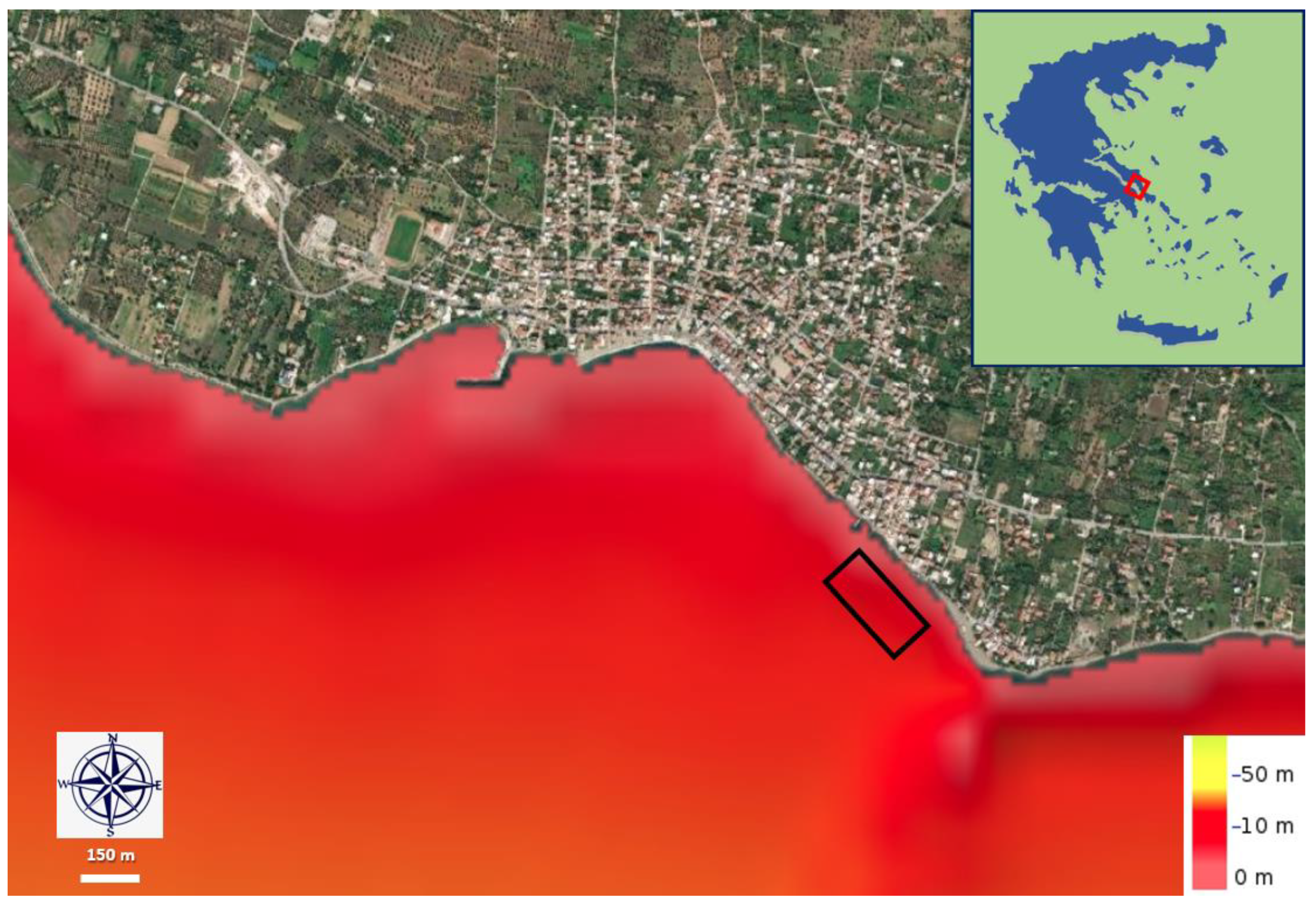
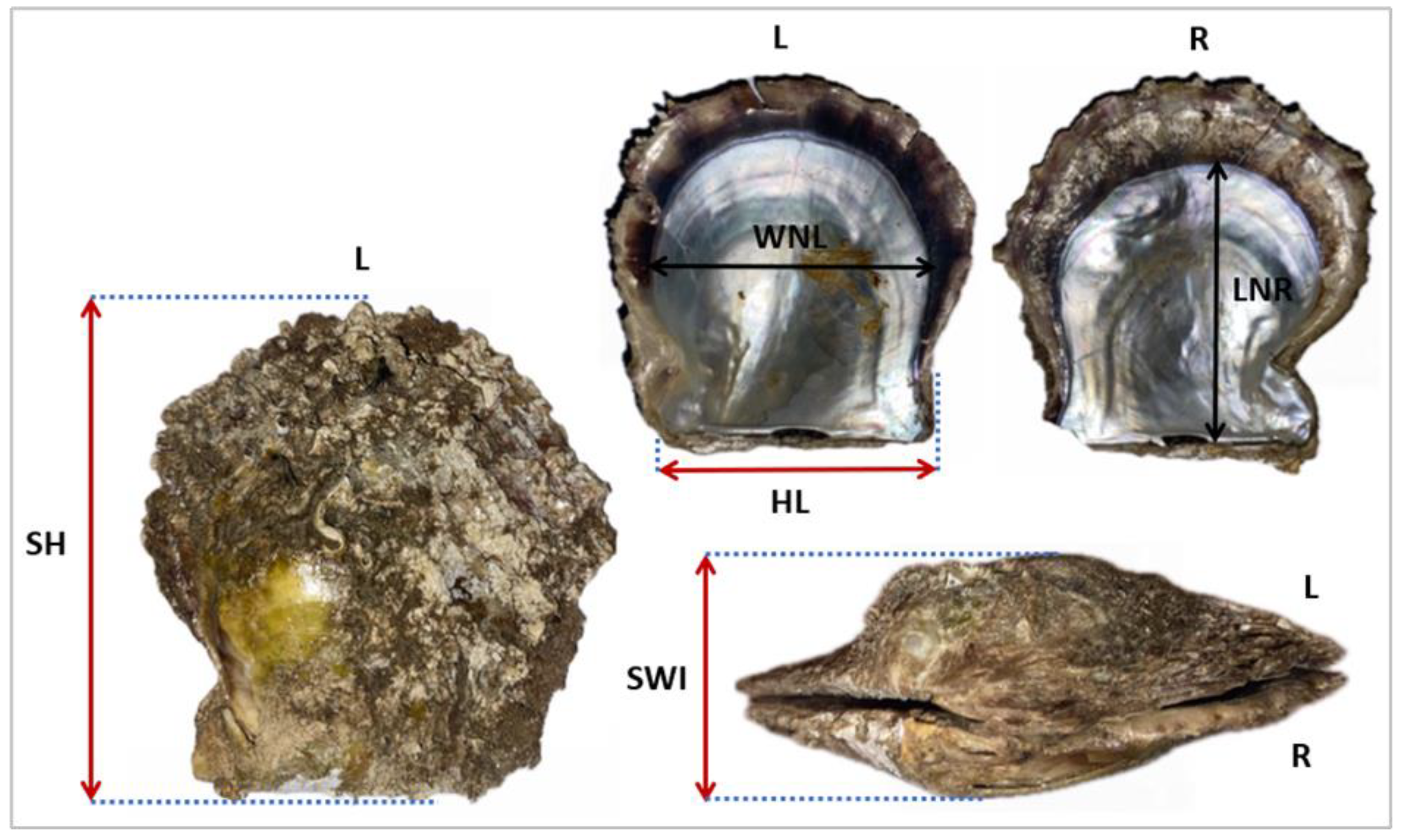
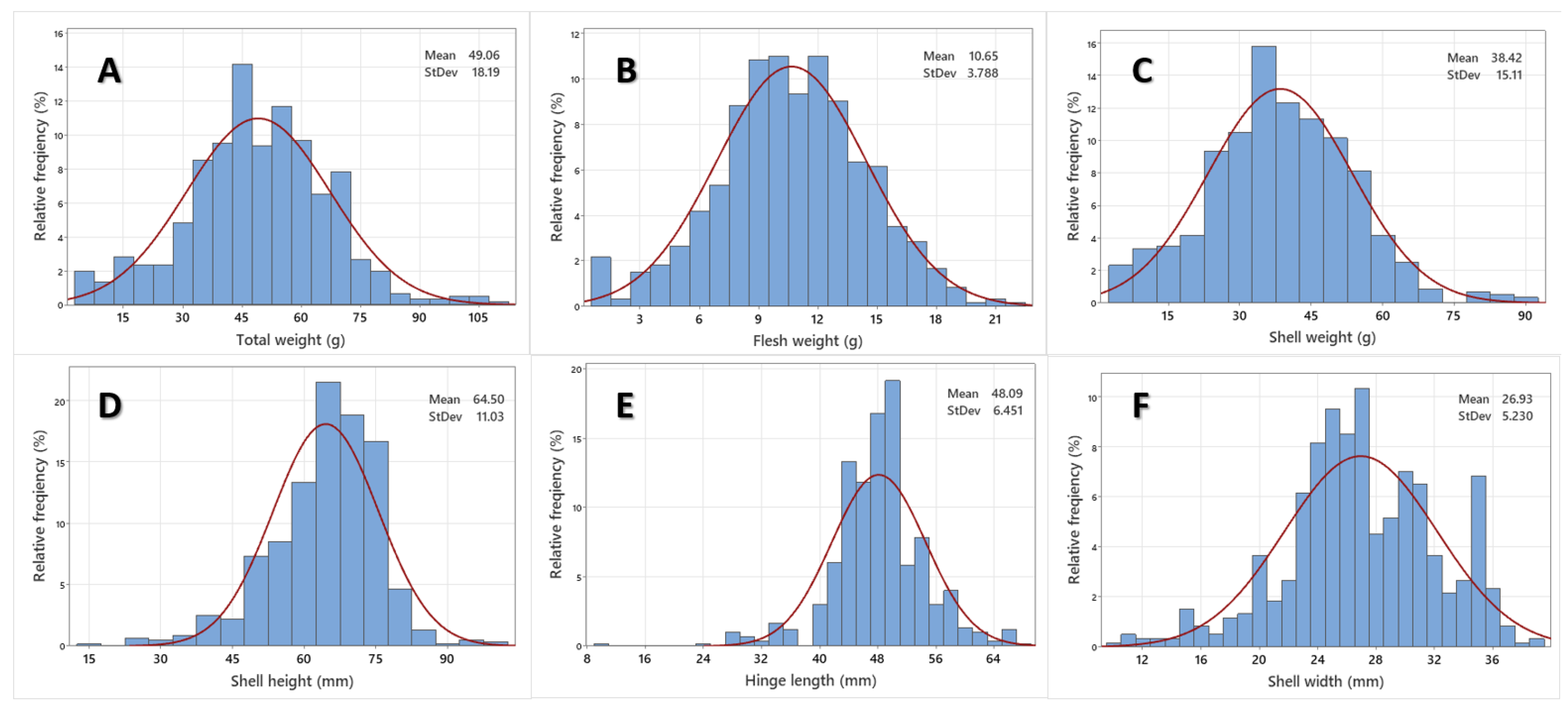

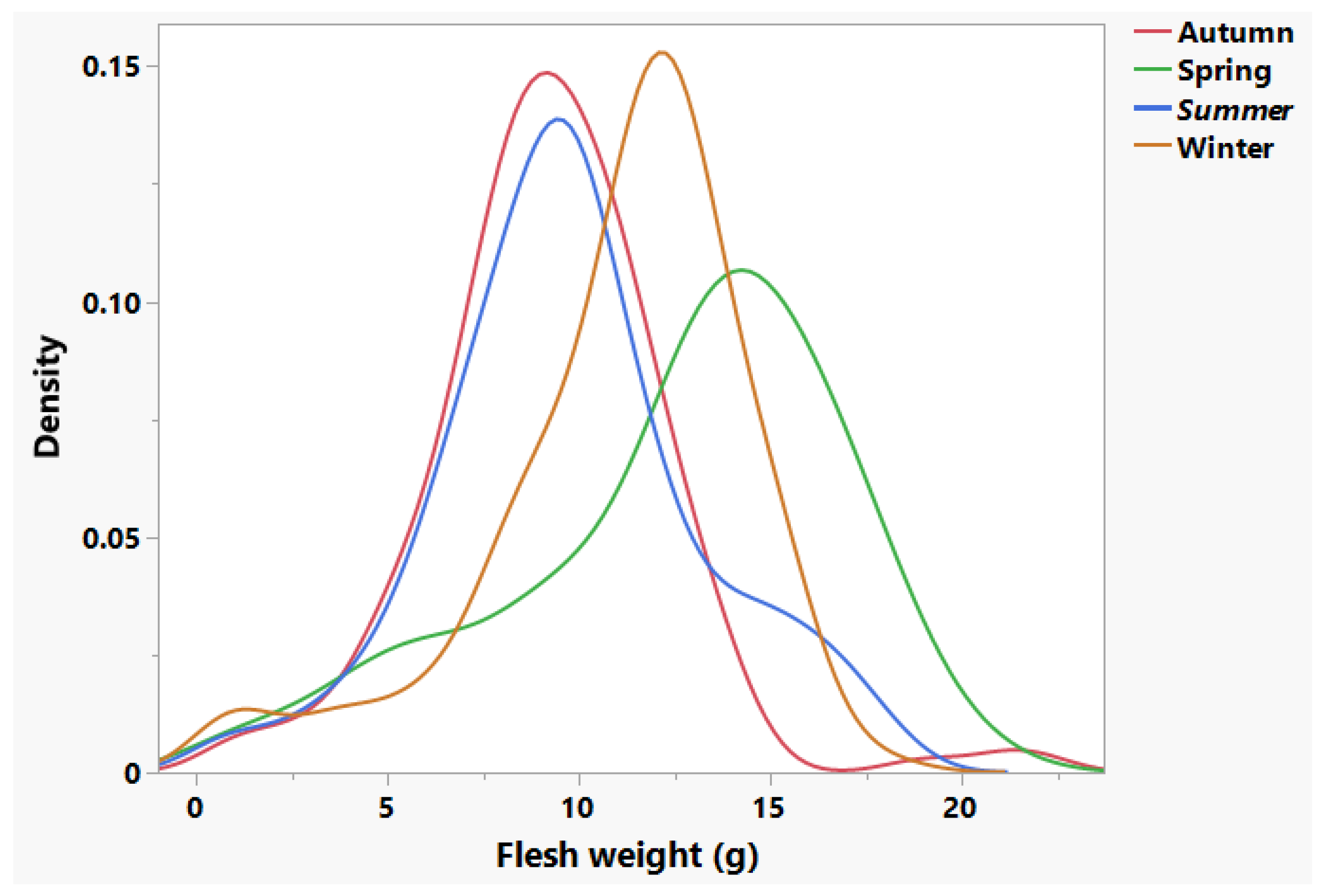
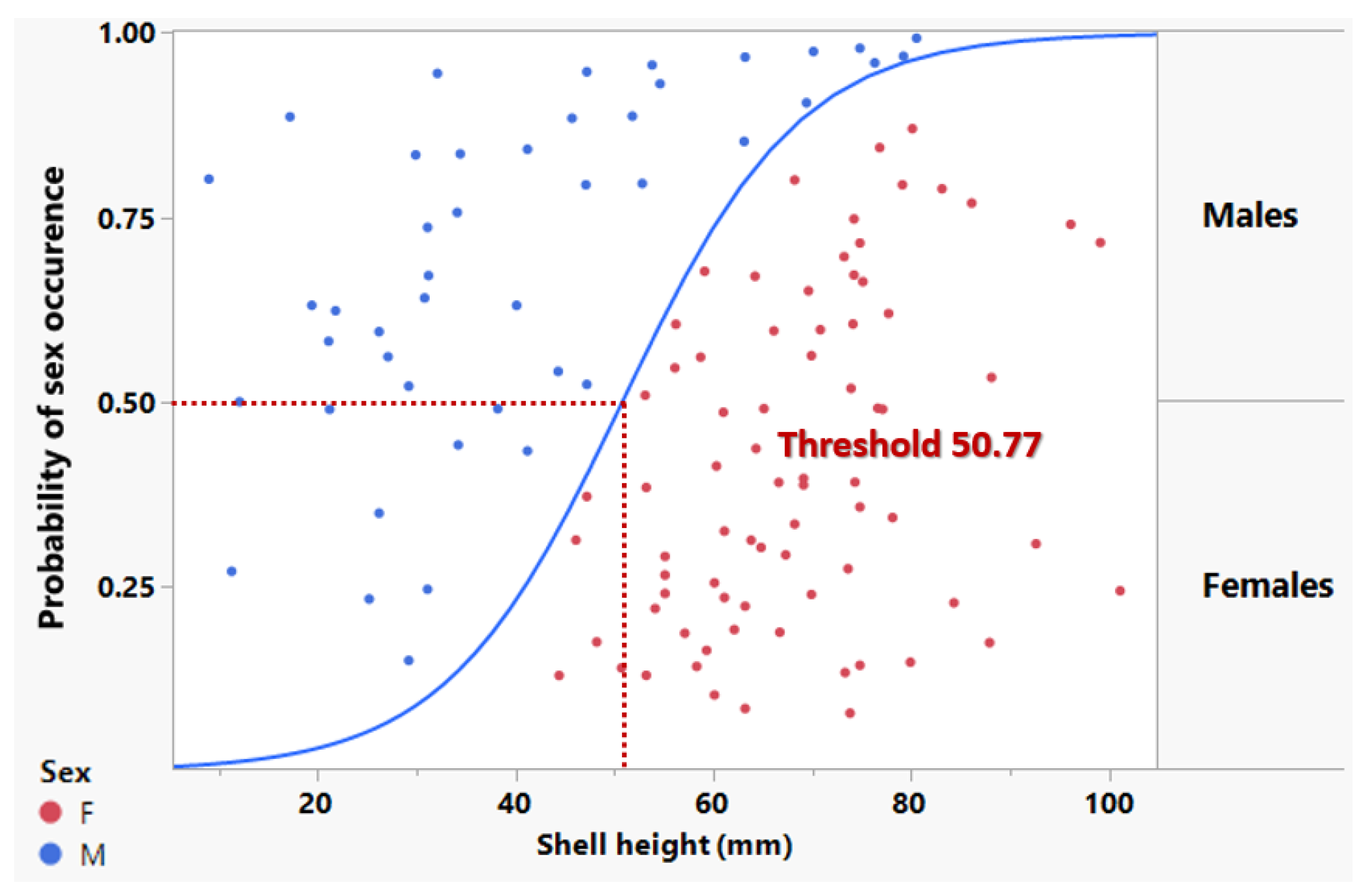

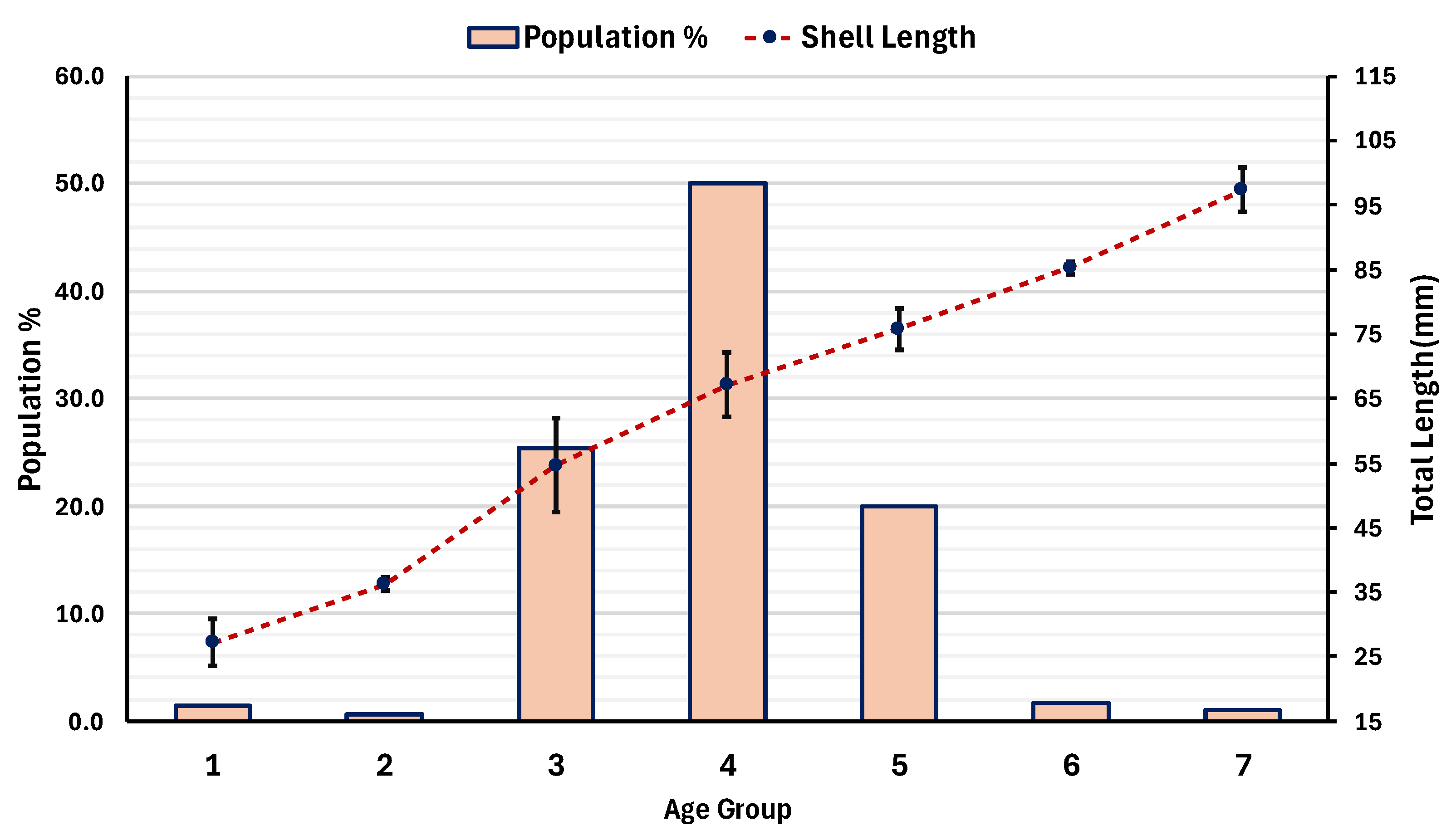
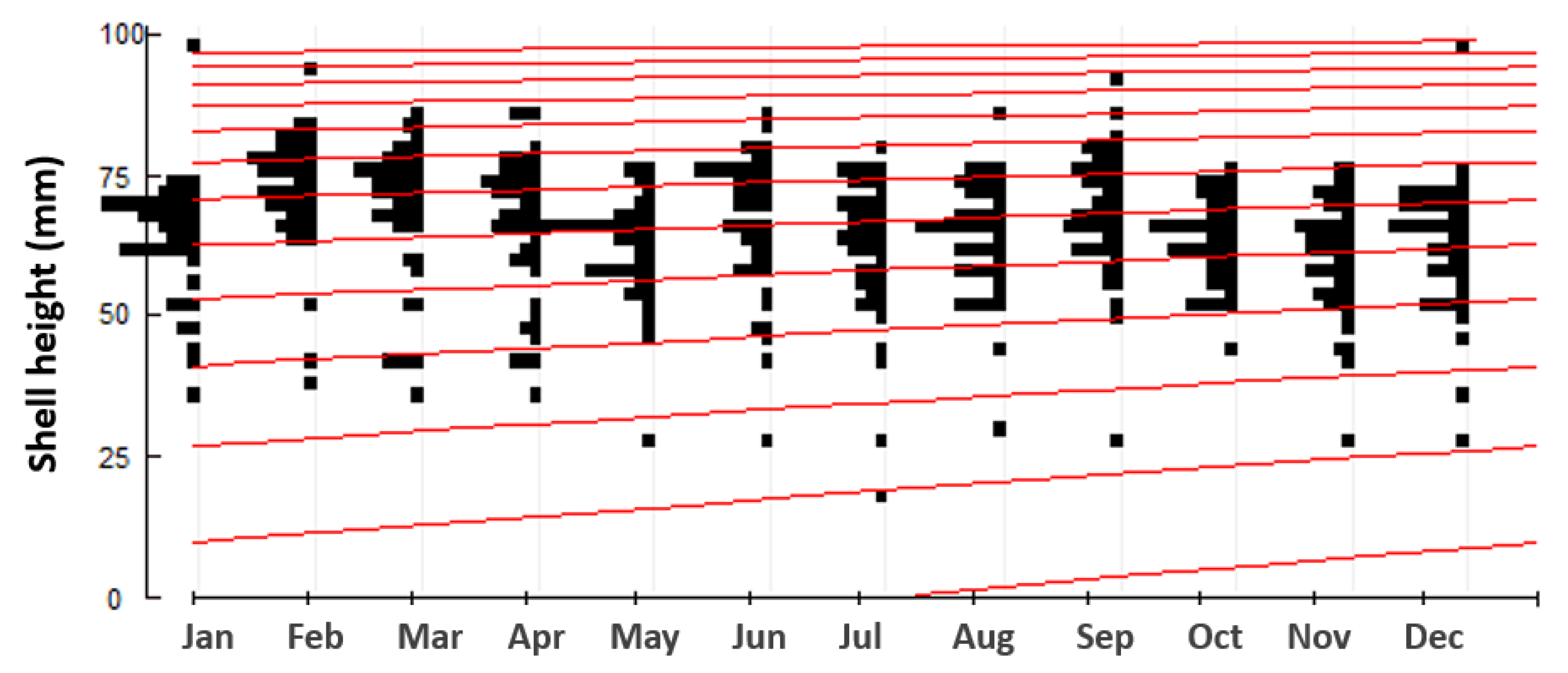


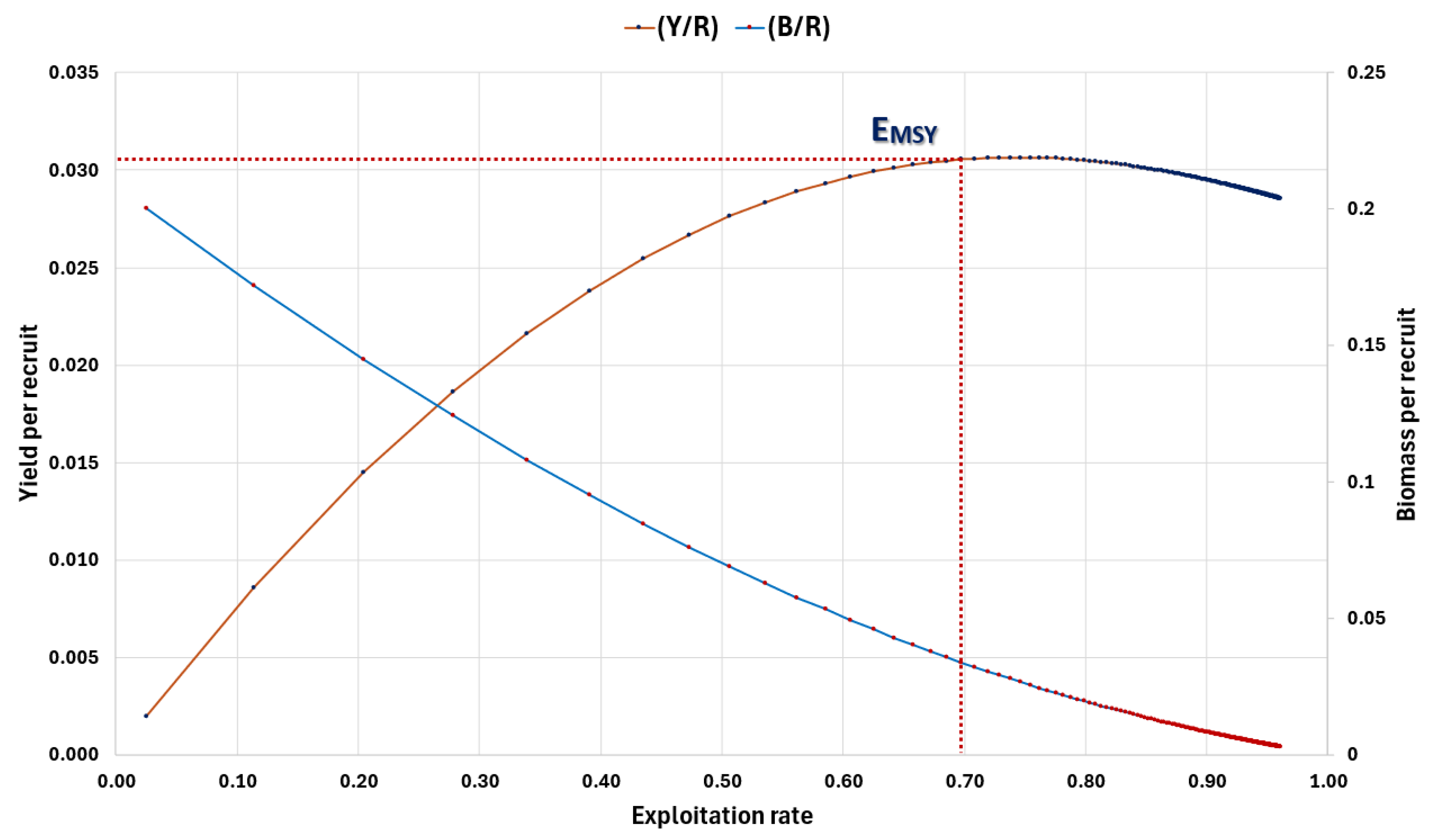
| Season | Autumn | Winter | Spring | Summer | Significance | Total Population |
|---|---|---|---|---|---|---|
| TW ± SE | 47.7 ± 17.2 | 51.9 ± 18.6 | 48.9 ± 19.9 | 47.8 ± 16.6 | ns | 49.1 ± 18.2 |
| FW ± SE | 9.27 ± 3.06 c | 11 ± 3.34 b | 12.6 ± 4.36 a | 9.76 ± 3.41 c | *** | 10.7 ± 3.79 |
| SW ± SE | 38.4 ± 14.4 | 40.8 ± 15.7 | 36.3 ± 16 | 38.1 ± 14 | ns | 38.4 ± 15.1 |
| SH ± SE | 63.3 ± 9.78 | 66 ± 11.2 | 65.2 ± 11.7 | 63.6 ± 11.2 | ns | 64.5 ± 11 |
| HL ± SE | 47.8 ± 5.33 | 48.9 ± 6.91 | 48.1 ± 6.80 | 47.7 ± 6.63 | ns | 48.1 ± 6.45 |
| SWI ± SE | 26.3 ± 5 | 27.4 ± 5.37 | 27.4 ± 5.52 | 26.6 ± 4.99 | ns | 26.9 ± 5.23 |
| WNL ± SE | 41.7 ± 7.09 | 43.7 ± 7.53 | 42.3 ± 7.97 | 41.7 ± 7.86 | ns | 42.3 ± 7.64 |
| LNL ± SE | 47.2 ± 7.08 | 48.8 ± 7.60 | 48.5 ± 8.39 | 47.3 ± 8.08 | ns | 48 ± 7.82 |
| WNR ± SE | 46.8 ± 6.52 | 48.2 ± 7.76 | 47.2 ± 8.58 | 46.8 ± 8.28 | ns | 47.3 ± 7.83 |
| LNR ± SE | 51.9 ± 7.49 | 53 ± 8.3 | 53.1 ± 8.95 | 51.8 ± 8.74 | ns | 52.4 ± 8.39 |
| Average Temperature | 21.5 ± 1.6 | 15.2 ± 2.0 | 15.2 ± 1.7 | 24.2 ± 1.54 |
| Term | Scaled Estimate | Std Error | t Ratio | Significance | |
|---|---|---|---|---|---|
| Intercept | 10.6525 |  | 0.146025 | 72.95 | *** |
| Autumn | −1.385833 |  | 0.252922 | −5.48 | *** |
| Spring | 1.8988333 |  | 0.252922 | 7.51 | *** |
| Summer | −0.893833 |  | 0.252922 | −3.53 | ** |
| Winter | 0.3808333 |  | 0.252922 | 1.51 | ns |
| Relationship | Equation | R2 | t-Test | Allometry |
|---|---|---|---|---|
| SH vs. TW | TW = 0.008205 × SH 2.0824 | 84.9% | *** | Negative |
| SH vs. FW | FW = 0.006241 × SH 1.7821 | 70.9% | *** | Negative |
| SH vs. SWI | SWI = 0.71535 × SH 0.87123 | 61.4% | *** | Negative |
| SH vs. SW | SW = 0.00499 × SH 2.14 | 77.7% | *** | Negative |
| SH vs. HL | HL = 3.6505 × SH 0.61969 | 68.6% | *** | Negative |
| HL vs. SW | SW = 0.79975 × HL 0.90825 | 41.2% | ns | Negative |
| SW vs. FW | FW = 1.0617 × SW 0.63844 | 61.9% | *** | Negative |
| E | Y/R | B/R | |
|---|---|---|---|
| 0.01 | 0.008 | 0.844 | |
| 0.20 | 0.014 | 0.699 | |
| 0.30 | 0.020 | 0.566 | |
| 0.40 | 0.024 | 0.444 | |
| 0.50 | 0.028 | 0.336 | |
| 0.60 | 0.030 | 0.241 | |
| 0.70 | 0.031 | 0.159 | |
| 0.80 | 0.030 | 0.093 | |
| 0.90 | 0.029 | 0.040 | |
| 0.99 | 0.028 | 0.003 | |
| Biological reference points | |||
| FMSY | 0.934 | ||
| EMSY | 0.637 | ||
| BMSY | 0.03295 | ||
| Emax | 0.694 | ||
| E0.1 | 0.616 | ||
| E0.5 | 0.353 | ||
| Fopt | 0.39 | ||
| Flim | 0.26 | ||
| Eopt | 0.50 | ||
Disclaimer/Publisher’s Note: The statements, opinions and data contained in all publications are solely those of the individual author(s) and contributor(s) and not of MDPI and/or the editor(s). MDPI and/or the editor(s) disclaim responsibility for any injury to people or property resulting from any ideas, methods, instructions or products referred to in the content. |
© 2024 by the authors. Licensee MDPI, Basel, Switzerland. This article is an open access article distributed under the terms and conditions of the Creative Commons Attribution (CC BY) license (https://creativecommons.org/licenses/by/4.0/).
Share and Cite
Pafras, D.; Theocharis, A.; Kondylatos, G.; Conides, A.; Klaoudatos, D. Population Biology of the Non-Indigenous Rayed Pearl Oyster (Pinctada radiata) in the South Evoikos Gulf, Greece. Diversity 2024, 16, 460. https://doi.org/10.3390/d16080460
Pafras D, Theocharis A, Kondylatos G, Conides A, Klaoudatos D. Population Biology of the Non-Indigenous Rayed Pearl Oyster (Pinctada radiata) in the South Evoikos Gulf, Greece. Diversity. 2024; 16(8):460. https://doi.org/10.3390/d16080460
Chicago/Turabian StylePafras, Dimitris, Alexandros Theocharis, Gerasimos Kondylatos, Alexis Conides, and Dimitris Klaoudatos. 2024. "Population Biology of the Non-Indigenous Rayed Pearl Oyster (Pinctada radiata) in the South Evoikos Gulf, Greece" Diversity 16, no. 8: 460. https://doi.org/10.3390/d16080460






